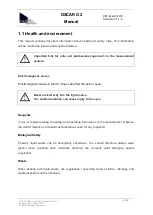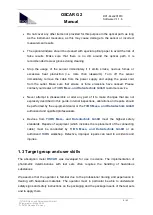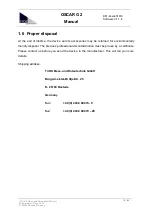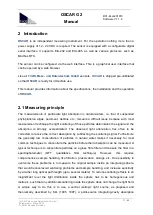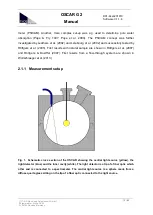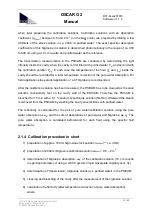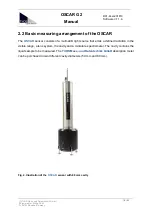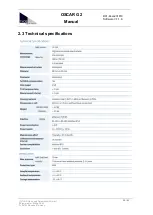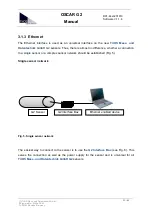
OSCAR G2
Manual
D01-44en201810
Software V.1.1.6
(C)TriOS Mess- und Datentechnik GmbH
Bürgermeister-Brötje-Str. 25
D- 26180 Rastede/Germany
15 / 62
2.1.3 Calibration
The error for absorption determination in a PSICAM is related mainly to the error in
determining the inner radius
r
, the reflectivity of the PSICAM
, and to the “transmission”
determination in the PSICAM. The “transmission” measurement is further influenced by the
stability of the light source and the spectroradiometer response. From these errors the error
related to
has the strongest influence: a 1 % error in
leads to
>
10 % error in the
absorption determination. Hence,
has to be known with a high accuracy. It is determined
using Eq. (7), by measuring the “transmission” induced by two solutions with known
absorption coefficients.
Determining
in this way has the advantage that it will eliminate errors associated with the
true
of the wall material, and with
r
0
,
a
A
,
a
B
, and the known water absorption. However, the
error of the necessary determination of the absorption coefficient with a photometer directly
influences the error of the absorption determination with the PSICAM.
Practically
is determined following the suggestion by and description in Leathers et al.
(2000). Therefore the transmission
T
AB
is determined from a sample solution
A
with an
absorption coefficient
a
A
measured against a reference solution
B
with an absorption
coefficient
a
B
in the PSICAM. The reference solution
B
consists simply of purified water. The
assumed absorption coefficient spectrum of this purified water
a
w
, is taken from published
pure water absorption coefficients, whose were adjusted and smoothed to have a complete
spectrum for the considered wavelengths range. As discussed above any error in this pure
water absorption is compensated by the calibration procedure described here, the exact pure
water absorption is of less significance.
The sample solution
A
is prepared from the coloured stain Nigrosine (see
www.sigmaaldrich.com product nr. 198285 or Certistain, Merck, Germany), following
suggestions of Kirk (1997). Compared to other dye solutions Nigrosine has the advantage of
having a considerably high absorption coefficient at all required wavelengths.
A Nigrosine stock solution is prepared by dissolving a few crystals of Nigrosine in 100 ml
purified water. The optical density of this solution is roughly determined photometrically in a
1 cm cuvette at 578 nm, to be able to calculate the necessary volume of this stock solution






